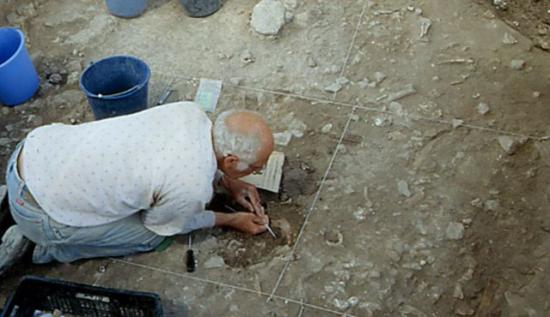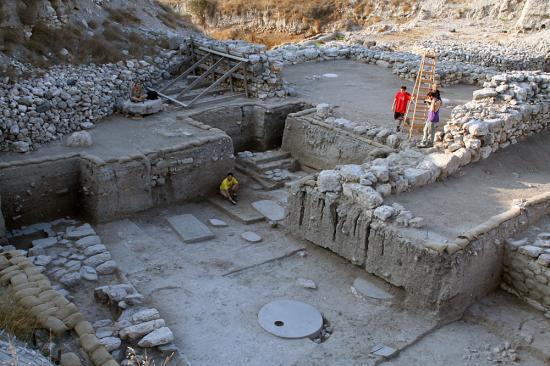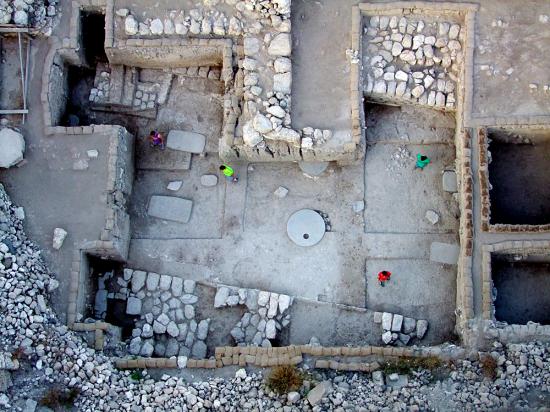We don’t know what gods were worshiped at this vast edifice but the evidence shows ritual discarding of animal bones.
Ran Shapira
Source - http://www.haaretz.com/archaeology/.premium-1.618583

Animal bone remnants found in the favissae in the rear of the temple. Photo by Israel Finkelstein
Who the gods worshiped at Tel Megiddo more than 5,000 years ago were remains unknown. But the ceremonies that took place at the vast Great Temple unearthed there clearly involved animal sacrifice.
The evidence was found in two long, narrow corridors in the main structure of the impressive temple, which were full of bone refuse. So was a third corridor which served as an access path to them.
The archaeologists excavating the Great Temple – Dr. Matthew J. Adams, Prof. David Ussishkin, and Prof. Israel Finkelstein – postulate that the corridors (favissae) served to ritually discard the bones after the animals' sacrifice. We cannot know why they stored the bones, but it could have had to do with cultic belief in the sacred nature of the sacrificial refuse.
The bones themselves were examined by Dr. Brian Heesse and Dr. Paula Wapnish from Pennsylvania State University, who discovered that different locations along the corridors were used to store different debris from different stages of the animals' carcass processing.Most of the remains found – more than 80 percent – are of young sheep and goats. The rest were cattle.
Ritually discarded bones
The structured deposit of the remains "lend support to the sanctity of the process and suggest that there was a ritual dimension to the discard process," suggest the researchers In an article published last April in The American Journal of Archaeology.
The temple was one of the largest structures in the Near East of its time (Early Bronze Age, 3300-2500 B.C.E.). The corridors with the bones were in its rear.
The bones in the western corridor contained bones with cut marks, which probably came from early stages of carcass processing. The bones in the eastern corridor showed signs of burning – indicating they were "the remains from later stages of carcass processing and utilization, i.e., discard from meals and burned detritus," Hesse and Wapnish wrote.
Also, the western corridor contained lots of limb bones, while the eastern one had mainly head fragments but few limbs. This bolsters the hypothesis that each corridor was used as a deposit for sacral refuse resulting from different rituals or different stages of a ritual.

Remains of a vast 5,000-year old temple at Tel Megiddo. We don't know who was worshiped there but animals were sacrificed to the deity. Photo by Israel Finkelstein
That's about all that can be said about the religious rituals at Megiddo at the Early Bronze Age, says Finkelstein. Precious little else is known about sacrificial activity in temples in ancient Israel and the Levant at that time period.
It would be reasonable to assume that animals were sacrificed at the temple from its construction until it was abandoned about a hundred years later, but that cannot be proved. Archaeologists are divided on why the temple, in which so much had been invested, was abandoned: some think there is evidence for a "killer earthquake" that hit Megiddo, which is located on the Carmel fault, but others reject that theory.
The temple was discovered in 2010 by the Tel Aviv University Megiddo Expedition, which has been working at the tel since 1992.
Vast scale of construction
Part of the uncertainty regarding ritual activity at the Great Temple of Tel Megiddo stems from the structure's sheer uniqueness.
Dated to the latest phase of the Early Bronze (3000 B.C.E.), the Great Temple is the most monumental single structure uncovered so far from the Early Bronze Age in the Levant.
The building contains a vast sanctuary 47.5 by 22 square meters in area. The size of the building itself, which covers 1,100 square meters in area, has no equal of its era: it's more than ten times bigger than the average temple of the time, which was around 100 square meters in size.

This bird's-eye view of part of the Megiddo temple shows its vast dimensions. Photo by: Israel Finkelstein
A path paved with basalt rocks led to the entrance to the temple, opposite which stood the altar. Along the longitudinal axis of the sanctuary ran a row of twelve column bases, wrote Adams with three other researchers in a report published lately in the journal Near Eastern Archaeology .
The column bases were flanked by two rows of round and rectangular basalt slabs, each weighing about a ton.
Adams, an Egyptologist, points to an interesting feature in the design of the temple. The structure was laid out according to a grid using a 52.5-cm standard unit of measurement.
"This is a known standard in use in Egypt at a later date. We don't know where it originated," Adams says. "It's theoretically possible that this was an Egyptian standard already in use during the construction of the temple, and therefore evidence of an Egyptian connection. There is still the possibility that it was a Levantine standard later taken over by the Egyptians."
No other known connections are known to the Egyptian culture at the time of the Great Temple, he says.
Although the temple at Tel Megiddo is the biggest of its time, at least found so far, it isn't the only example of construction on a vast scale turns in ancient Israel. Just recently archaeologists decided that a moon-shaped structure 150 meters long dating from about the same time, some 5,000 years ago, isn't a vast city wall as had been thought, but a monument, though nobody has any idea what it "meant". The residents of a nearby town, Bet Yerah, which is near Tel Meggido, had trade relations with Egypt, say the archaeologists.